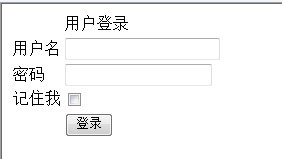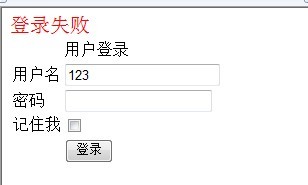这一节讲解下ASP.MVC 2.0的用户登录与注销功能,先讲登录,后说注销。我们这个系列讲的用户登录方式都是FORM表单验证方式。在讲之前先给大家说下<%:%>的功能,<%:%>与<%=%>功能一样,用来动态输出内容。
一、登录
1. 建立MODEL
登录的时候,我们一般只要验证用户名和密码,还有是否保存登录COOKIE,所以我们建立一个MODEL登录类,只需包括3个字段就可以。
|
1
2
3
4
5
6
7
8
9
10
11
12
13
14
15
16
17
18
19
20
21
22
23
24
25
26
27
28
29
30
31
32
33
34
35
|
/// <summary>
/// 用户登录MODEL
/// </summary>
public class Login
{
/// <summary>
/// 用户名
/// </summary>
[DisplayName("用户名")]
public string UserName
{
get;
set;
}
/// <summary>
/// 密码
/// </summary>
[DisplayName("密码")]
public string UserPwd
{
get;
set;
}
/// <summary>
/// 是否保存COOKIE
/// </summary>
[DisplayName("记住我")]
public bool RememberMe
{
get;
set;
}
|
2.建立VIEW页面
同样登录的VIEW页面,同样建立一个强类型的页面,之所以喜欢建立强类型的页面,是因为页面和MODEL相关联,在页面中直接可以使用MODEL。此时页面的视图数据类应选择MvcLogin.Models.Login。
|
1
2
3
4
5
6
7
8
9
10
11
12
13
14
15
16
17
18
19
20
21
22
23
24
25
26
27
28
29
30
31
32
33
34
35
36
37
38
39
40
41
42
43
44
45
46
47
48
|
<%@ Page Language="C#" Inherits="System.Web.Mvc.ViewPage<MvcLogin.Models.Login>" %>
<!DOCTYPE html PUBLIC "-//W3C//DTD XHTML 1.0 Transitional//EN" "http://www.w3.org/TR/xhtml1/DTD/xhtml1-transitional.dtd">
<html xmlns="http://www.w3.org/1999/xhtml" >
<head runat="server">
<title>Login</title>
</head>
<body>
<div style="font-size:15pt;color:Red;">
<%if (ViewData["msg"] != null)
{%>
<%:ViewData["msg"].ToString()%>
<%} %>
</div>
<div>
<%Html.BeginForm();%>
<table>
<tr>
<td></td>
<td>用户登录</td>
</tr>
<tr>
<td><%:Html.LabelFor(m=>m.UserName) %></td>
<td><%:Html.TextBoxFor(m=>m.UserName)%></td>
</tr>
<tr>
<td><%:Html.LabelFor(m=>m.UserPwd) %></td>
<td><%:Html.PasswordFor(m=>m.UserPwd) %></td>
</tr>
<tr>
<td><%:Html.LabelFor(m=>m.RememberMe) %></td>
<td><%:Html.CheckBoxFor(m=>m.RememberMe) %></td>
</tr>
<tr>
<td></td>
<td><input type="submit" value="登录" /></td>
</tr>
</table>
<%Html.EndForm(); %>
</div>
</body>
</html>
|
Html.CheckBoxFor用来生成一个复选框按钮
3.建立controller
同样我们在controller中建立两个login方法,一个用来展现页面,一个用来点击登录按钮后判断用户名和密码
|
1
2
3
4
5
6
7
8
9
10
11
12
13
14
15
16
17
18
19
20
21
22
23
|
public ActionResult Login()
{
return View();
}
[HttpPost]
public ActionResult Login(Models.Login model)
{
if (new Models.SqlHelper().UserLogin(model))
{
//如果用户名存在,转向主页
FormsService.SignIn(model.UserName,model.RememberMe);
return RedirectToAction("index");
}
else
{
//登录失败,转向登录页面
ViewData["msg"] = "登录失败";
return View(model);
}
}
|
第二个Login方法前面有HTTPPOST属性,所以只能接受POST请求
4.SQLHELPER中添加判断用户名和密码的方法
|
1
2
3
4
5
6
7
8
9
10
11
12
13
14
15
16
17
18
19
20
21
|
/// <summary>
/// 判断用户登录是否成功
/// </summary>
/// <param name="model"></param>
/// <returns></returns>
public bool UserLogin(Login model)
{
strUserExist = string.Format(strUserExist, model.UserName, model.UserPwd);
SqlConnection con = new SqlConnection(conStr);
con.Open();
SqlCommand cmd = new SqlCommand(strUserExist, con);
SqlDataAdapter adp = new SqlDataAdapter(cmd);
DataSet ds = new DataSet();
adp.Fill(ds);
con.Close();
if (ds != null && ds.Tables[0].Rows.Count > 0)
{
return true;
}
return false;
}
|
5.运行登录页面
此时我们在页面中输入URL,就会转向登录页面,
效果如下:
点击登录,登录成功后转向首页,登录失败返回本页面,并显示提示信息。
点击登录的时候,是POST提交方式,会调用publicActionResult Login(Models.Login model)方法。
登录失败页面如下
登录成功页面如下
二.注销
登录成功后,转向首页,在首页上我们会生成注销连接。
|
1
2
3
4
5
6
7
8
9
10
11
12
|
<p style="font-size:15pt; color:Red;">
<%if (Request.IsAuthenticated)
{%>
欢迎您<%:Page.User.Identity.Name%>!
<%:Html.ActionLink("注销", "LoginOff")%>
<%}
else
{%>
<%:Html.ActionLink("登录", "Login")%>
<%} %>
</p>
|
这里介绍下Html.ActionLink方法,
Html.ActionLink用来生成一个链接,第一个参数代表链接的问题,第二个参数代表的是actionname,可以理解为链接的页面。
由以上代码可以看出,注销链接指向LoginoFF.,也就是controller中的loginoff action方法,所以我们在controller中添加一个一个loginoff方法,执行完loginoff方法后,会转向INDEX首页
|
1
2
3
4
5
6
7
8
9
|
<span style="font-family:Microsoft YaHei;font-size:16px;"> </span>/// <summary>
/// 用户注销
/// </summary>
/// <returns></returns>
public ActionResult LoginOff()
{
FormsService.SignOut();
return RedirectToAction("index");
}
|
以上就是Asp.Mvc 2.0实现用户登录与注销功能实例讲解,大家可以在自己的网站上进行实践了,希望在此基础上可以有所创新和完善。
相关文章
- ASP.NET自助建站系统中的用户注册和登录功能定制方法 2025-06-10
- ASP.NET自助建站系统的域名绑定与解析教程 2025-06-10
- 个人服务器网站搭建:如何选择合适的服务器提供商? 2025-06-10
- ASP.NET自助建站系统中如何实现多语言支持? 2025-06-10
- 64M VPS建站:如何选择最适合的网站建设平台? 2025-06-10
- 2025-07-10 怎样使用阿里云的安全工具进行服务器漏洞扫描和修复?
- 2025-07-10 怎样使用命令行工具优化Linux云服务器的Ping性能?
- 2025-07-10 怎样使用Xshell连接华为云服务器,实现高效远程管理?
- 2025-07-10 怎样利用云服务器D盘搭建稳定、高效的网站托管环境?
- 2025-07-10 怎样使用阿里云的安全组功能来增强服务器防火墙的安全性?
快网idc优惠网
QQ交流群
-
2025-06-04 34
-
java sql ResultSet 之getRow()用法说明
2025-05-29 83 -
2025-05-29 80
-
2025-05-29 49












